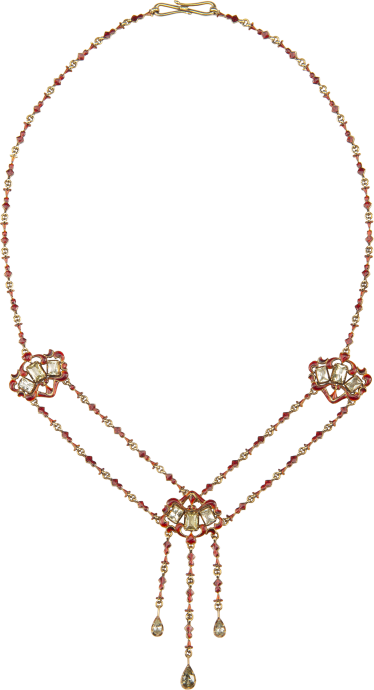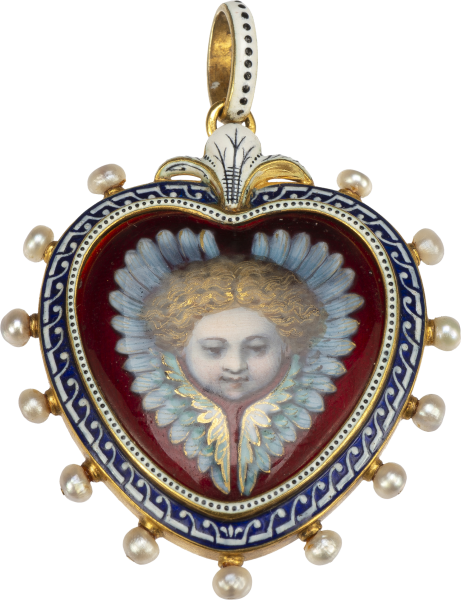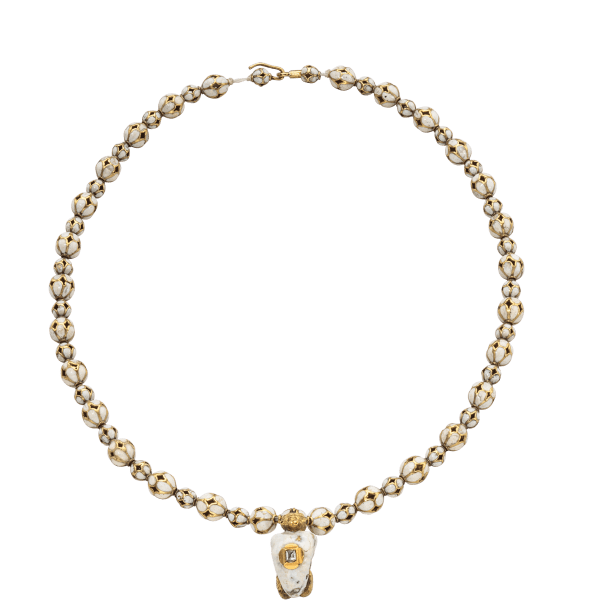


Renaissance Style Necklace
, France (Paris), c. 1890; England (London), c. 1895
Renaissance Style Necklace
Description
Gold necklace with red translucent enamel. The centerpiece is formed of three elaborate scrollwork elements, each framing three, fanned out chrysolites in open settings. These are connected by double chains of stylized floral links in red enamel, and the same links create the three pendants in tapering lengths with pear-drop chrysolites, suspended from the central element, as also the chain around the neck with s-shaped hook fastening. On the hook clasp is the maker’s mark “C&AG.”
Original fitted brown leather case, gilt triple frame, inset with cream colored velvet and on the matching silk lining of the lid is in gold imprint: A crown, C & A Giuliano/ 115, Piccadilly/London.
Self-described as an “art jeweler,” Giuliano began his career on Frith Street in London in 1860. Without a retail shop of his own, he initially supplied jewels to other London firms – Robert Phillip, C. F. Hancock, and Hunt and Roskell. By 1874, he was open for business at 115 Piccadilly, described as a “treasure trove.” He gradually moved away from earlier revival styles and worked closely with artists from the Arts and Crafts Movement in Britain, becoming friends with members of the Pre-Raphaelite circle, who inspired his jewelry. After his death in 1895, the firm continued on Piccadilly with his sons Carlo and Arthur.
The design of this exceptionally elegant necklace echoes Renaissance-style scrollwork in a unique interpretation, whilst its delicate composition and bold use of translucent red enamel is influenced by British Arts and Crafts jewelers. Contrasting well with the chrysolite gemstones and diamonds, the translucent red enamel is probably also due to the influence of India. Indian jewelry was exhibited at the Crystal Palace in London in 1851, then again in 1886. A bequest of Giuliano jewelry in 1895 to the Victoria and Albert Museum included work said to be “in imitation” of the enameled work of Jaipur.
Describing the “Art of the Jeweller” in a paper delivered in 1889 and later published, Carlo Giuliana states: “A piece of goldsmiths’ work need not necessarily be expensive; it is the style, the design, the form, that will give that grace and refinement which will give one joy or pleasure….” Giuliano’s words “grace and refinement” describe well the impeccable taste of this beautiful necklace.
Literature:
Munn 1984, esp. pp. 54, 129, and 139–141.

